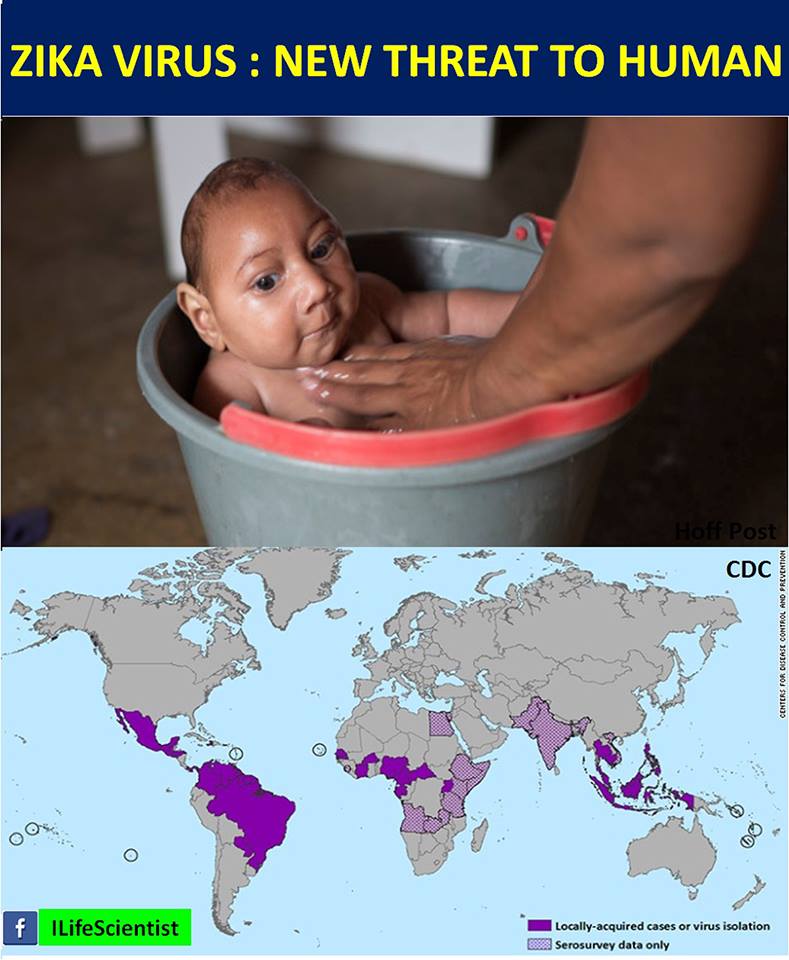2015年10月8日和10月16日之間,巴西和哥倫比亞《國際衛生條例》國家歸口單位向世衛組織/泛美衛生組織通報了寨卡病毒感染病例。
巴西
2015年5月,巴西公共衛生當局確認該國東北部地區發生寨卡病毒本土傳播。截至10月8日,在14個州已經發現寨卡病毒本土病例:阿拉戈阿斯、巴伊亞、塞阿拉、馬拉尼昂、馬托格羅索、帕拉、巴拉那、帕拉伊巴、伯南布哥、皮奧伊、裏約熱內盧、北裏奧格蘭德、羅賴馬和聖保羅。
由國家和州行政部門采取的公共衛生措施包括:製定並分發寨卡病毒哨點監測操作規程,製定並驗證神經綜合征監測和媒介控製活動的操作規程。
哥倫比亞
截至2015年10月16日,從玻利瓦爾省獲得的98個標本中(13個來自卡塔赫納,85個來自圖爾瓦科),有9個標本經實驗室確認存在寨卡病毒感染。這是在該國首次發現的寨卡病毒感染病例。
背景
寨卡熱是由寨卡病毒引起的一種蚊媒病毒病,包括輕微發熱、紅疹(多數為斑丘疹)、頭痛、關節痛、肌肉痛、無力以及非化膿性結膜炎,這些症狀在受到蚊子叮咬後三至十二天出現。四分之一的病人可能不會出現症狀,但受到感染的人員中通常出現的輕微疾病症狀可能會持續二至七天。其臨床表現往往與同為蚊媒傳播疾病的登革熱類似。

自2014年以來,已經發現寨卡病毒在美洲存在本土流行。2014年2月,智利公共衛生當局確認在複活節島發現了寨卡病毒感染首位本土傳播病例,病例報告一直持續到2014年6月。最近在世界上不同地區出現寨卡病毒熱的疫情表明,蟲媒病毒能夠通過伊蚊所在的領土傳播。
世衛組織建議
由於寨卡病毒在美洲區域的傳播出現上升,世衛組織/泛美衛生組織建議其會員國建設並且保持用以發現和確認寨卡病毒感染病例的能力,衛生服務部門要做出準備,應對衛生保健所有層麵可能出現的負擔加重情況,並采取有效的公眾交流策略,減少引起該病傳播的蚊蟲數量,尤其是在該蟲媒已經出現的地區。
寨卡病毒是一種SS RNA病毒。在疫區,有許多感染的母親生出的孩子有小頭畸形,因此孕婦要格外小心,預防感染,盡量避免進入疫區。

嬰兒在下列情況需要做寨卡病毒的測試檢驗:
1)嬰兒有小頭畸形;
2)母親可能感染寨卡病毒。
關於寨卡病毒:
Zika is ssRNA containing virus primarily spread by mosquito and human serves as natural host. It causes Zika fever in human characterized by fever, rashes, joint pain and conjunctivitis. In May 2015 Pan American Health Organization (PAHO) issued an alert regarding the first confirmed Zika virus infections in Brazil. WHO is expecting 4 million cases of Zika virus alone in America by the end of 2016. Unborn children are biggest threat to this virus and babies were born with deformed heads to virus infected mothers. New born babies with shrunken skull called microcephaly a congenital deformation of the skull that compresses the infants' brain. Thus pregnant women should be more cautious in travelling to Zika infected area.
CDC的通告:
Interim guidelines for testing infants with Zika virus
CDC has developed interim guidelines for health care providers in the U.S. who are caring for infants born to mothers who traveled to or resided in an area with Zika virus transmission during pregnancy. These guidelines include recommendations for the testing and management of these infants.
Pediatric health care providers should work closely with obstetric providers to identify infants whose mothers were potentially infected with Zika virus during pregnancy (based on travel to or residence in an area with Zika virus transmission) and review fetal ultrasounds and maternal testing for Zika virus infection.
Zika virus testing is recommended for 1) infants with microcephaly or intracranial calcifications born to women who traveled to or resided in an area with Zika virus transmission while pregnant; or 2) infants born to mothers with positive or inconclusive test results for Zika virus infection. For infants with laboratory evidence of a possible congenital Zika virus infection, additional clinical evaluation and follow-up is recommended. Health care providers should contact their state or territorial health department to facilitate testing.
The only way to prevent congenital Zika virus infection is to prevent maternal infection, either by avoiding areas where Zika virus transmission is ongoing or strictly following steps to avoid mosquito bites. Mosquito-bite prevention includes using air conditioning or window and door screens when indoors, wearing long sleeves and pants, using permethrin-treated clothing and gear, and using insect repellents.
 選擇“Disable on www.wenxuecity.com”
選擇“Disable on www.wenxuecity.com”
 選擇“don't run on pages on this domain”
選擇“don't run on pages on this domain”

